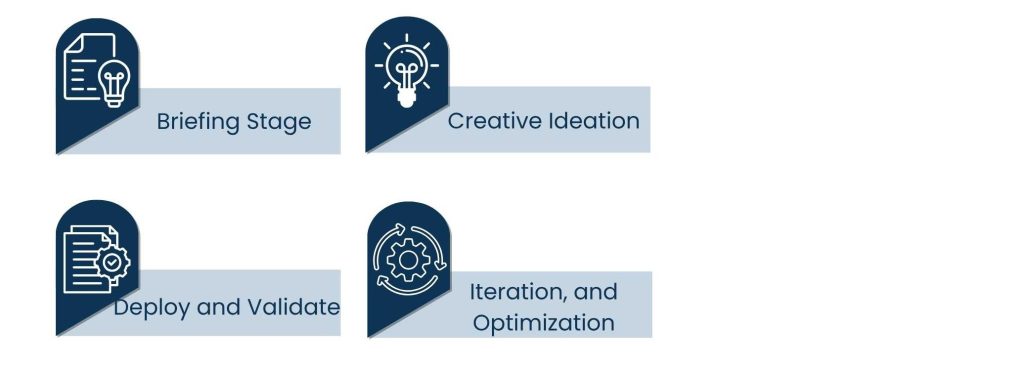Introduction
Marketing data analyst positions do not just stop at churning out dashboards and reports; they are now the strategists, creatives, and executors all in one. We are in an age where the industry is striving to put out campaigns that not only attract engagement but also ensure performance, and hence, it has become necessary for analysts and creative teams to work together.
Even the best design in the world can garner attention, but when it is accompanied by insight, it gets people to take action eventually. This is where the marketing data analyst comes in; someone who can understand the balance between good and effective.
Analysts are brought in to estimate audience behavior, content performance, and channel trends well before a campaign even begins. Designers, writers, and strategists can produce concepts based on actual data of viewership patterns rather than a hunch. Every creative decision, from choosing the right messaging tone to honing in on an ad format that works best, becomes more purposeful.
On top of that, they do not simply collaborate when a feature is shipped. Analysts are responsible for real-time testing and performance tracking, and also ensure teams iterate quickly, keeping creative responses in line with what moves the needle when it comes to clicks, conversions, and engagement.
Marketing, data, and design are partners in today’s digital environment. The marketing data analyst fuels that relationship.
Why This Collaboration Matters?
Marketing data analysts and creative teams have complementary skill sets that aren’t always seen as aligning in the same lane. But when they do, the results are impressive and grounded in data. Storytelling, images, and emotional connections? That’s the territory of creative professionals. The best design in the world matters little if it is directed to the wrong people, at the wrong time, or even if it is sent through the wrong channel.
Which is where the marketing data analyst comes in, not to curtail creativity, but to inform it with laser precision.
But behind any campaign coming to life is the data and analytics team dissecting through data to unveil trends, favorite tastes, and performance headlines. Those are not just numbers; they are cues that help understand where it pays to shape the direction of the creative.

These are the key questions that a marketing data analyst answers before launch:
- Who is the actual audience? Targeting Segments: these include Behavior, Demographics, and Intent as defined by your analysts.
- What message will resonate? They dissect old engagements to understand tone, keywords, and the flavour of the month.
- Which formats work best? Analysts break down performance data at the format level between video, static ads, carousels, long-form content, etc., to determine how to design their content.
- What point does the audience get most engaged with? They know where to direct creative energy, from social to search, email to apps.
Having the depth of insight available to creative teams allows them to make their work more strategic and effective. They aren’t designing on a guess, but are instead designing for known likes. They are creating ads that are designed to work, rather than wide-net campaigns.
The result? Brilliantly beautiful and wildly successful campaigns.
However, this partnership does not rely only on pre-launch. When campaigns go live, the same marketing data analysts provide real-time performance feedback, etc. They monitor which creative variations are clicking, what headlines are lifting time on page, and what’s not working. This allows creatives to iterate and optimize without guessing.
In other words, art is a collaboration between science. It assures storytelling is insight-driven and every asset has a role in delivering results.
Creative Execution Supported by Key Marketing Data Analyst Skills
Data is not just an asset post-campaign, but also in providing the correct direction for launching more effective campaigns. Leading this effort is the marketing data analyst. That expertise is not only good for strategy or performance, it can also give designers, writers, and the brand team an easier job right from the start.

This is how their specialization influences execution:
1. Audience Segmentation and Persona Development
Marketers see their audience splintered into many discrete, data-driven groups by marketing data analysts. It extends beyond the basic demographics and includes buying behavior, content engagement patterns, and platform activity. The message gets sharper and more tailored when creatives know who they are designing for.
2. Channel and Format Insights
Some content just strikes the right note to help you resonate with your audience on a particular channel. They analyze which creative formats, such as videos, carousels, infographics, and long-form articles, perform best on which channel. It enables creatives to create for the right medium as opposed to battling with other groups fighting over recycling assets across each outlet.
3. A/B Testing and Conversion Data
Interpreting A/B Tests In Marketing Data Analyst Skills Analysts can identify which headline, CTA, layout, or image version drove more conversions. They turn test results into concrete, creative guidance on what to keep, kill, and scale.
4. Content Engagement Metrics
Analysts keep an eye on bounce rates, click-throughs, and time spent on each page. This way, creative teams can collect insights on user behavior. This helps reduce guesswork in creative decisions.
5. Predictive Modeling and Trend Forecasting
Data analysts find trends they can forecast for performance. This enables creatives to match campaign messaging and visuals with prospective changes in behavior, whether that be related to seasonality or the latest trends in content.
All this, when combined, makes the marketing data analyst a complete partner in creativity. They’re not just validating ideas later on but helping define what gets made in the first place. This partnership makes certain that creative teams are not only making pretty work but producing impactful work.
How Collaboration Typically Works
Collaboration between marketing data analysts and creative professionals is not an afterthought in high-performing Go-To-Market teams; it’s part of the process. This partnership also guarantees that impressive creative work is made, not just made to look impressive. The more each side knows about the data, ideas, and feedback of the other from early in a cycle through accessible means to engage in collaborative decision making throughout, the sharper campaigns get faster, becoming even stronger.

This is what that partnership looks like when it goes right between the two:
1. Briefing Stage: Data Points The Way
The data analyst in marketing puts together a performance snapshot before any brainstorming. These insights include audience segments, content engagement patterns, how effective each channel is, and what’s been working recently — or not. And yes, the point is not to throw numbers around aimlessly but to simply provide context for creatives as they think about who they are building all this cool stuff for, what their audience is talking about, and where they can find them.
2. Creative Ideation: Insight-Informed Brainstorming
Their creative team starts concepting with data in hand. This is a long way away from just taking stabs in the dark at what might work; it’s about aligning their ideas with tried and tested themes, formats, and user preferences. All messaging, visuals, and layouts are crafted with purpose, aimed at the personas and platforms where they will be most powerful.
3. Deploy and Validate: Real-Time Tracking
When assets are already live, the market data analyst sees them performing in real-time. Whether that is A/B testing ad creatives, comparing email subject lines, or measuring scroll depth on landing pages, these analysts can very quickly get a read of what direction they are going in.
4. Iteration, and Optimization: Refines Creative, Guides Analyst
The feedback loop never ends after going live. Creative teams change images, words in headlines, or the layout itself based on early performance signals, sometimes just as they are in the middle of a campaign. The analysts who remain useful while campaigns run (and require updates) have real-time insights, making them quicker and know more than any guesswork.
That type of synergy not only results in a stronger outcome, but it also embodies shared accountability. The wood-paneled yet refreshingly inventive environment seems to keep its analysts committed to creativity. Creatives feel more secure that their work isn’t just a gut feeling. But leadership sees campaigns that engage and deliver.
When data and design go hand-in-hand, every campaign acts as a test-and-learn chance where each iteration is one step closer to reaching peak performance.
Creating the Vocabulary of Data and Design
Though tools and workflows are vital, the script flips on its head when you establish a culture where marketing data analysts speak to creative teams effectively, no longer just due to cross-protocols.
No good things come from seeing IT as a department to drop everything on, nor does it help them view the business as just someone who interrupts their lives.
Data is siloed from the creative boards in most companies. Yet in a data-driven org, analysts join creative kickoffs & designers contribute to post-release performance retrospectives. The outcome? Campaigns that are super clear on day one — these have objectives, measurable KPIs, and are executed thoughtfully.

To create and maintain this kind of culture, follow these steps:
1. Get Analysts Involved Sooner, Not Just After Launch
Include your marketing data analyst in creative briefs. Allow for input from them on your audience, channel preferences, and past performance trends before arriving at ideas. That gives creative teams a better road map.
2. Teach Both Sides of the Language
Analysts encourage cross-team learning in identifying brand tone, visual design concepts, and messaging. They let creatives learn how to read performance dashboards, understand basic metrics like CTRs or CPC, bounce rates, and conversion goals.
3. Recognize Team Achievements, Not Just Individual Metrics
When something goes well, celebrate the idea and the insight equally. A well-performing email subject line was not written by gut; it was more likely a continuation of what had been influencing open rates, which could have been influenced in one particular way for months. Acknowledging shared victories builds respect and paves the way for future partnerships as well!
4. Inspire via data, not control
Make it clear that the analyst’s role is to refine ideas, not to kill. Data as Fuel, Not Friction: Collaboration flows much more easily when creatives see data as fuel rather than a frictionary factor.
In the end, marketing data analysts and creatives are tackling the same issue: how to use creativity to inspire your target audience to act? They collaborate when there is open communication and a common context.
This is when the true secret: where true insight meets imagination, and that creative strategy meets storytelling.
Conclusion
The seamlessness between marketing data analysts and creative teams is not a nice-to-have, but now an absolute necessity. As marketers, the effectiveness of our campaigns hangs on being able to perform and engage, but in a performance and engagement world, connecting data with design is what propels superior results.
By having analysts enter the room early to bring insights, creatives are designing work that will not only look nice but also be strategically aligned. It just forces a higher level of intention into every single headline, layout, visual, and format. This enables teams to iterate and adjust while incrementing and optimizing team dynamics, not iterating for how they feel it should work, but based on what works through feedback that is real-time feedback.
A reminder that this collaboration is bigger than any one campaign. It’s a cultural shift. Talent should view analysts as enablers, not gatekeepers. Where designers are thought of as an intrinsic element in your performance, not a wildcard.
The best brands are set up on one side with solid design principles and creativity, and on the other with data-driven insights and predictive modeling that are integrated into fast-moving marketing engines, a relationship built for success, if you will. That begins with bringing the marketing data analyst into every part of the creative process, and treating them as a valuable co-collaborator instead of a roadblock or dictator.
About Us
Tasks Expert offers top-tier virtual assistant services from highly skilled professionals based in India. Our VAs handle a wide range of tasks, from part time personal assistant to specialized services like remote it support services, professional bookkeeping service etc. Furthermore, it helps businesses worldwide streamline operations and boost productivity.
Ready to elevate your business? Book a Call and let Tasks Expert take care of the rest.









